PART I — From the Foams of Paphos
Illustrated by NIKOS STAVROULAKIS
A few years ago Selwyn Lloyd argued against the Greekness of Cyprus by saying the island was connected with Southern Asia Minor and Syria. He went on to say that Cyrpus had been closely tied politically to Greece only during the fourth century B.C. True, but true enough? Both were, after all, part of the Byzantine Empire for the better part of eight centuries.
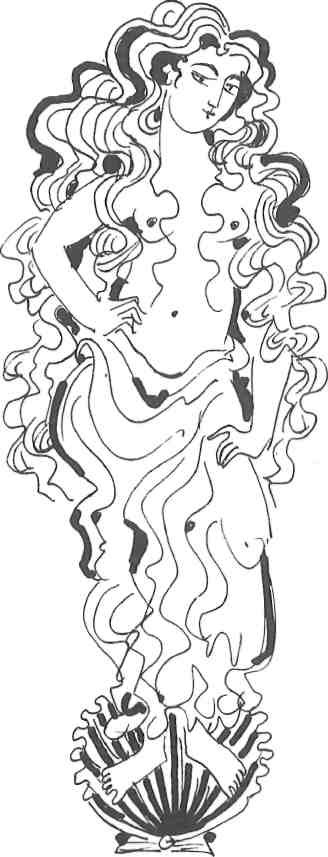
Sir Ronald Storrs, who was governor of the island for six years, came to a different conclusion: ‘The Greekness of Cypriots is, in my opinion, indisputable. Nationalism is more, is other, is greater than 164 pigmentations or cephalic indices. A man is of the race of which he passionately feels himself to be. No sensible person will deny that the Cypriot is Greek-speaking, Greek-thinking, Greek-feeling.
Both are right then in their way. History presents us with unmistakable facts which on the one hand cannot be neatly arranged but on the other hand can prove perilous if ignored.
In the late sixteenth century Stephen de Lusignari, a Dominican friar and descendant of the royal house of Lusignan which had ruled Cyprus for over 250 years, gave a description of that island during the last days of Venetian rule. He describes the ‘peculiar herbs’ and ‘perfumes’ of the island: white apium, a sort of water-celery, which is ‘eaten crystallised in sugar’; oldanum which is used to make a liqueur; the ‘Cyprus Tree’ (black cypress), similar to the pomegranate, which flowers in clusters like the vine, and whose distilled leaves produce the orange dye that is used to colour the tails of gentlemen’s horses, ‘as is customarily seen there.’ He lists a wealth of strange medicinal herbs before turning to the curious beasts, — the species of cattle he had never seen before — wild donkeys, boars and the ‘vine-bird’ which were pickled in vinegar, packed in barrels, and shipped by the thousands to Venice and Rome.
The curious biology of Mediterranean islands, isolated as if under a bell jar, is something of which naturalists have long been aware. But what of their human inhabitants? Are not their fierce individualism, their highly distinctive traits, due to much the same thing? As Fernand Braudel observes, ‘like an enlarged photograph, the history of the islands affords one of the most rewarding ways of approaching an explanation of this violent Mediterranean life. It may make it easier to understand how it is that each Mediterranean province has been able to preserve its own irreducible character, its own violently regional flavor in the midst of such an extraordinary mixture of races, religions, customs and civilizations.’
L.M. Ugolini, excavating in Malta a few years ago, put forward the interesting hypothesis that Mediterranean civilization may not have originated in the East, as is commonly supposed, but in the western part of that sea, well before the second millenium B.C. A bit fanciful perhaps, but it is not difficult to imagine this vital force of the sea passing from island to island, peninsula to peninsula, returning after hundreds or thousands of years, altered, and in turn altering, but still part of a single evolutionary and civilizing process. Two neolithic settlements cheek by jowl at Khirokitia — the earlier dating back to the sixth mellenium — are themselves over a thousand years apart. What happened in the meantime?
With Cyprus as with most Mediterranean lands, we begin in myth and never quite escape it. Cyrpus certainly was the home of Aphrodite. Aphrodite of Paphos was one of the greatest of all Mediterranean cults. Most likely we see her as Botticelli represents her, but his is only a partial portrait. The words of Euripides are familiar, too:
Ο let me come to Cyprus,
island of Aphrodite,
home of the loves that cast
their spells on the hearts of men!
Or Paphos where the hundred
mouthed barbarian river
brings ripeness without rain!
There the lovely Graces go,
and there Desire…
One might be deceived by the charm, if one did not recall that the work is The Bacchae and the voice is that of the Chorus which six hundred lines later will commit mayhem, murder and cannibalism.
She is also the ‘laughter-loving’ goddess of Homer. But not always. Here she is in Book III of the Iliad, addressing her devotee, Helen:
Wretched girl, do not tease me lest
in anger I forsake you
and grow to hate you as much as
now
I terribly love you,
lest I encompass you in hard hate,
and you wretchedly perish.
Clearly a woman of many moods, not to be taken lightly. The same is true of her children. So it can come as no surprise to those of experience that the Garden of Aphrodite should have its fair share of nettles.
Who was this Aphrodite of Paphos? Of her forefathers we know little. About her foremothers we are better informed. The patriarchal links may be dismissed as we may dismiss her consorts — as mere boys! The dove-goddess, Aphrodite-Astarte is descended, according to the Hittite hieroglyphs, from Kupa-pa, the goddess of Carchemish. This Kupapa, with her consort Sandas, emanates from Anatolia where we meet her as Kybebe, or the more familiar Cybele. Farther back she clearly dscended from the Minoan dove-goddess. But she seems to have also had Egyptian connexions as the Euripides quotation above suggests with its reference to the Nile.
Helen, as her priestess and frequently as her alter-ego, played a number of roles. Queen of Sparta was but one of these. Indeed, there is a tradition that Helen never went to Troy at all — only her wraith — and that the whole war was fought over a phantom. (A thing that can be said of a good many wars). This tradition says that she went to Phoenicia and to Egypt. Herodotus refers to a shrine of ‘Aphrodite the Stranger’ at Memphis, which he visited. A conciliatory variant is that Paris picked Helen up in the temple of holy prostitution at Paphos itself and took her to Troy from there.
What does all this seem to imply? It is taken to mean that the first Greeks coming from the Aegean to Cyprus were Achaeans of the late Mycenaean period who brought a proto-Aphrodite cult with them. They were traders at first who became colonists — the Flag following the Trade in this case. Under the Homeric hero Teucer, they founded the city of Salamis, named after the Saronic island which had been their home. Trading as well with Syria and Egypt they may have set up their worship of the Goddess in those areas too.
The Astarte connexion became close when the Phoenicians conquered Cyprus in the ninth century B.C. In turn the Egyptian relation came about when the Pharoahs annexed the island in the sixth century.
Sea-born Aphrodite: the epithet is apt. Truly she is the Eastern Mediterranean’s child — just as her island is — and the personification of the vital force and the volatility of the sea itself.
The immense importance of the Aphrodite cult, and the wealth of her temple gave the high-priest of Paphos a position far broader than his religious functions. This priesthood became a theocracy exerting power throughout the island, an influence that has extended down through the centuries. The British Vice-Consul in the middle of the last century observed that the temporal powers enjoyed by the Archbishop of Cyprus were analagous to the old powers of the high-priest of Aphrodite.
By the sixth century BC the power of Cyprus was centered at Salamis where it remained throughout the classical period. But there, too, the Teucrid dynasty of kings claimed a priestly role. Although the island passed under Persian domination, it enjoyed an undefined independence. The ties with mainland Greece were strengthened during this period, and in all the cities there were strong anti-Persian factions. Coins of this period suggest, in fact, especially close connexions with Athens and Eretria. Ironically so, for Athens and Eretria were the two cities on the mainland that joined the Ionian Revolt against Persian.
The repercussions from this war led to one of those sudden, spasmodic popular rebellions which keep reappearing in Cypriot history. Gorgos, king of Salamis, had a younger brother, Onesilus, who tried to persuade the king to revolt. Unsuccessful in this, Onesilus sought another course: while his brother was out of the city, he seized the opportunity to close the gates against him. Gorgos fled to the Persians. Onesilus mounted the throne and without difficulty persuaded all the cities of Cyprus, except for Amathus, to join him. The Persian fleet landed an army near Salamis and a great battle followed on land and sea. The Persians were defeated at sea by the Ionian allies of Cyprus but were victorious on land. Onesilus, after a heroic stand, was killed and his brother Gorgos was restored to the throne. Nevertheless it took a year for the Persians to reduce all the cities that had revolted. Curiously, we have no evidence that Cyprus had suffered under the earlier Persian domination while what we do have points to prosperity during this time. The history of Cyprus is full of such interesting omissions.

The head of Onesilus, Herodotus tells us, was hung on the gates of Amathus. In time it became hollow and was occupied by a swarm of bees who filled it with honeycomb. In response to this phenomenon, the townspeople consulted an oracle who sensibly advised them to take down the head and bury it. Such was the end of that Cypriot patriot.
Back under Persian domination, Cyprus was forced to supply men and ships for the war against Greece. In this they showed an admirably lukewarm enthusiasm. They managed to lose so many ships by capture and in storms that very few were left to fight at Salamis.
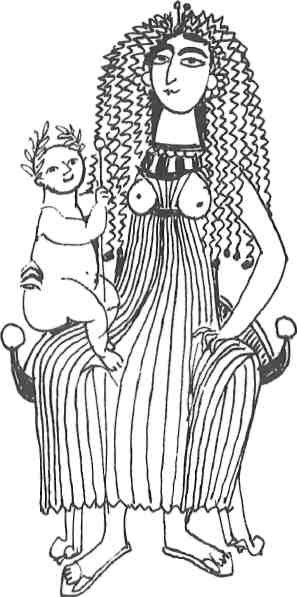
The greatest Cypriot figure of classical times was Evagoras I of Salamis (435 – 374). He was a member of the Teucrid dynasty whom the Persians had deposed, because of their Greek sympathies, in favor of a Phoenician despotism. The Teucrids, however, were supported by Athens and with its help Evagoras restored the Teucrids to power and mounted the throne of his ancestors.
The Athenian Empire was defeated within ten years of his accession. Nonetheless, Evagoras was able, in the disarray of the Persian Empire, to play off the various provinces of Egypt, Syria and Cilicia against one another. He kept strong ties with Athens where he was held in great honour. Eventually he was defeated by the Persians whose power was revived under Artaxerxes, but the Great King allowed him to retain the title of King of Salamis. Under the rule of Evagoras, the influence of Hellenism in Cyprus reached its zenith. He left a bankrupt state when he died, but Evagoras was gratefully remembered for his efforts to create a united and independent Cyprus.
After the death of Alexander the Great, Cyprus was fought over and despoiled by the Seleucids and the Ptolemies. The latter finally prevailed and the island remained under the domination of Egypt until 58 BC. In that year Ceasar’s henchman, P. Clodius Pulcher, carried a law in the Roman Senate to reduce Cyprus to the status of a province and to confiscate its royal treasury. By this act he was settling an old score.
Years before, Clodius, having been captured by Cilician pirates, had appealed to the Cypriote to pay his ransom. But the Cypriots offered a sum so small that the pirates in disgust let him go free without a ransom.
Cato was appointed to carry the transfer through. For Clodius the move was a master-stroke of humour as well as political policy: it secured him immense sums for his party and, at the same time, rid him of Cato, his most obstinate opponent, whose moralistic conscience must have been revolted by the task he was given. Cicero, too, became governor of Cyprus and though he ruled fairly, the island did not flourish under the Roman philosophers.
For a short while, however, Cyprus was returned to Egypt. How appropriate that the island of Aphrodite should be given by Julius Caesar to Cleopatra! A bronze coin was struck at this time on which Cleopatra appears as Aphrodite holding in her arms the infant Ptolemy, Caesar, her child by Julius. On her death, Cyprus again became a Roman province.
It was only seventy-five years later that there took place at Paphos the celebrated encounter between the Roman proconsul, Sergius Paulus, and Saint Paul. By striking blind the false Jewish prophet and magus Bar-Jesus, St. Paul so impressed Sergius Paulus that he at once converted. Thus Cyprus became the first land ever ruled over by a Christian.
Cyprus played a highly important role in spreading Christianity and gave to the early Church so many holy men that it became known as ‘the island of saints.’ Among them were Saint Barnabas, Saint Spyridon and Saint Mamas — the patron saint of tax-evasion.
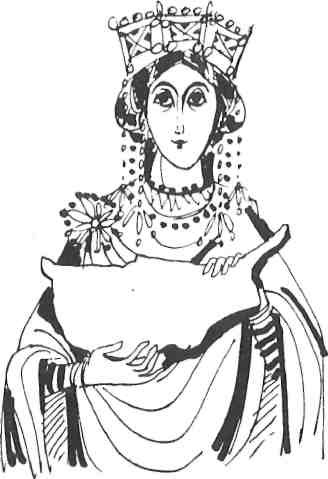
Yet the old tutelary deity of the island did not vanish with the advent of Christianity. From among the welter of saints arises the hectic figure of the Empress Theodora. The Empress was probably not born there, but her father, a bear-trainer, was of Cypriot origin.
Theodora is a figure of controversy. ‘The prositute who in the presence of innumerable spectators had polluted the theatre of Constantinople was adored as a queen in the same city.’ So wrote Gibbon. More generous are the words of H.A.L. Fisher: ‘Justinian looked into the gutter for a wife and picked out a diamond. One thing is certain: when the Empire was on the brink of civil war and anarchy it was her resolution that upheld the wavering Justinian and saved the state.’ In sophisticated times, myth is debased to fairy-tale or scandal but it well outlives the times themselves.
The independence of the Church of Cyprus was recognized at the Council of Ephesus in 431. Confirmed fifty years later by the Emperor Zeno, the independent Cypriot Church was one of the earliest autocephalous bodies in Orthodoxy, a thousand years older than the Church of Russia and fourteen hundred years older than the Church of Greece. Theocracy is one of the leitmotivs of Cyprus.
In the middle of the seventh century began the Saracen raids which for three hundred years were to bedevil so many of the islands of the Mediterranean. This period of Saracen piracy marks the dark ages of both Cyprus and Crete. In the middle of the tenth century Nicephorus II Phocas liberated both islands, but the restored peace was short-lived. Although the Saracens now ceased to trouble Cyprus, the preaching of the First Crusade was little more than a century away. Once again the rhythm of the Mediterranean was to make a sweeping turn which would last over half a millenium. The scourge of Cyprus was no longer the Arab East but the Christian West.
The Crusades are an episode of high romance which time has tarnished darkly. No amount of cleverness can draw a parallel between Aphrodite’s arrival on the tide at Paphos and Berengaria’s untimely arrival by ship. Contrary to popular belief, myths do not explode. They may be awkward, they may be primitive, but they try to tell the truth in their own terms. Romance, however, does explode and frequently, as it tries to hide precisely what myth tries to reveal. Its remnants are as worthless and as difficult to locate as those of a shattered balloon. Dead romances have only tales — and rather tall tales — to tell.
In the first place, Richard Coeur de Lion arrived in Cyprus by mistake. He and his betrothed, Berengaria, had been separated in a storm while on their way to the Holy Lands. (The Mediterranean was in one of its ironic moods.) At that time a Byzantine despot, well-versed in the refinements of cruelty, was trying to buttress a flagging regime in Cyprus and had only just succeeded in defeating an army sent out against him from Constantinople. In his infinite wickedness the despot Isaac sought to do violence to Berengaria, the virgin Navarresse princess washed up on his shore. He had not reckoned, however, with the power and courage of her English lover who had come to that part of the world as a Soldier of Christ to make good a bad bet and to retrieve the Holy Places from the infidel.
Divested of romance, the episode is true. Richard defeated Isaac and found himself with an island that he did not want, although he took enormous amounts of booty. Anxious to be on his way to Palestine, he left the island in the hands of a Frankish soldier-of-fortune, Guy de Lusignan. It proved to be the most lasting action of his life.
Richard’s chance conquest of Cyprus was no mere episode. The sultan Saladin of Egypt had all but destroyed the Latins in the Holy Land. With Richard’s appearance the situation was at once relieved. It became possible to provision the crusading forces in near-by Palestine, and Cyprus became the Crusaders’ base of operations for another century. Guy de Lusignan was succeeded by his far-sighted brother Aimery who converted a life-tenure into a dynasty that was to last over two hundred and fifty years.
The first century of the Frankish Lusignan rule in Cyprus is intimately linked with the vicissitudes of the Crusaders in Palestine. It is a well-documented period: the Assizes of Jerusalem preserve the laws of the kingdoms of Jerusalem and Cyprus, a relationship in which the island assumed a progressively more important role. Not only does this document tell us more about feudal society than any comparable text from Europe, it conclusively demonstrates that European society during the later Middle Ages had its origins in the Frankish life of Outremer.
With the fall in 1291 of Acre, the last foothold of the Latins in the Holy Lands was lost. For Cyprus, however, it was a new beginning. Again the rhythm of the Mediterranean was turning back, heaving up this time the astonishing history of Famagusta. The desolation and the splendor of this town are, to this day, among the most extraordinary sights of the Eastern Mediterranean.
The ruins of ancient Salamis lie a mere five miles north. This great city fell gradually into decay during the Hellenistic period. It was devastated by earthquakes which destroyed its acqueducts. Partly reconstructed in early Christian times, the city was renamed Constantia but its harbour silted up and it too decayed. Ammochostos (hidden sands — the general problem) lies again just south, a city whose name the Franks corrupted to the more euphonic Famagusta. It had no importance until the Third Crusade, at the end of the twelfth century.
Yet in 1340 Ludolf of Sudheim, speaking of Famagusta, reported: ‘It is the richest of cities, and her citizens are the richest of men. A citizen once betrothed his daughter, and the jewels of her headdress were valued by the French knights who came with us as more precious than all the ornaments of the Queen of France.’
The Spirit of Christ had thus been transformed into the spirit of commerce. So great was the wealth of Famagusta in those days, that the huge church of St. Peter and St. Paul was built by a Syrian merchant from a fragment of the profits made on a single trip with galleys from Beirut.
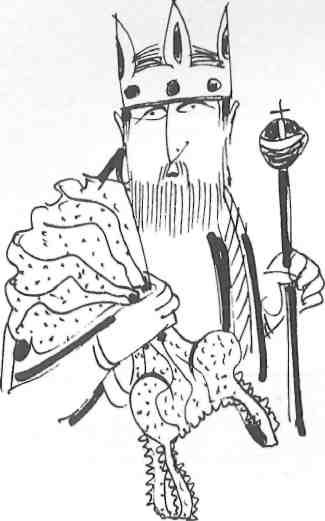
The anomalous situation of Cyprus, crusader island and fabulous depot of East-West trade, is seen clearly in the character of King Peter I. That he was the greatest of the Lusignan kings the Latin chroniclers leave us in no doubt. Peter had the wealth to make a crusade all his own. As a Christian warrior the Popes commended him. As the de-spoiler of the coasts of Anatolia and Syria and, above all, as the plunderer of Alexandria — a city whose wealth only Famagusta could rival — he could only be the despair of merchants and traders.
When at last he was bankrupted, Peter sought assistance in the West but in so doing ‘the Athlete of Christ’ left at home an unsatisfied wife, Elinor. That as he travelled about Europe in search of funds he slept with Queen Elinor’s nightgown, in no way diminished his extra-marital appetite. Though the queen was unfaithful herself, her activities did not cure her of jealousy. In the king’s absence the Queen’s fury fell on his mistress Joanna of Alemann, who, in pregnancy, was subjected to the foulest tortures. Somehow she survived, was delivered of her child, and worse, ‘her beauty was not diminished.’
This pathetic creature is one of the few Franks whom the Cypriots remembered. They put her sad plight into verse and called her Arodaphnousa — ‘mountain laurel’.
The Crusader King died in an odour of scandal. His liaison with Echiva de Scandelion proved fatal. Unbeknownst to them both, he and his son shared her favours. When the son learned of it, in his youthful jealousy, he had his henchmen cut off his father’s head.
A Worthy Petro king of Cypre,
also,
That Alisaundre wan by heigh
maistrye,
Ful many a hethen wroghestow ful
wo
Of which thyn owene liges hadde
anvye.
Chaucer might admire him from a distance but Peter’s reign was an anachronism and a catastrophe.
The debilitated state he left made the city prey to the interminable commercial rivalry of Genoa and Venice. The Genoese held Famagusta for fifty years, and when the Lusignans won it back in 1464, it was but a shell of its former greatness.
Peter’s great-nephew, King Janus, was not a bad man, but the fury of the Egyptians fell upon this successor of the fatally misguided Peter. The Mamelukes invaded Cyprus, overran the army of Janus at Khirokitia (of neolithic fame), captured him and dragged him in chains to Cairo. From then on Cyprus became tribute to the Mamelukes, and the proud days of the Lusignans were numbered.
It often happens that, when politics become decrepit, personalities take on new life. Janus’s grandson James II is the most interesting and, in many ways, the most sympathetic of all Lusignan kings. Of all these rulers he was the nearest to being Cypriot. That it took two hundred years for the Franks to achieve a Cypriot identity illustrates the narrowness of its society. James was a bastard, and as often happened in medieval times, his birth gave him a certain charm. His father was Frankish and his mother was Greek, and thus, although a bastard, James was the legitimate child of the culture that produced him. Out of such fusions the genius of the Eastern Mediterranean has often sprung.
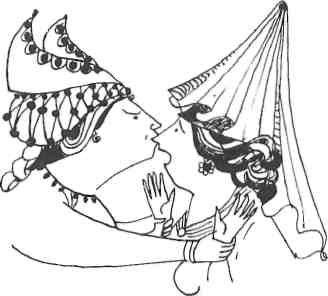
James II’s father had married Helena Paleologa and had by her his only legitimate child, Charlotte, who was also half-Greek. While the girl was still young, her father formed a liaison with James’s mother, a Greek, Marietta of Patras. The Queen, who was a hypochondriac and virago in one, became insanely jealous of her rival. During a quarrel, she bit off Marietta’s nose and the unfortunate Marietta came to be known as Komomytene (‘crop-nose’).
Charlotte was married to Louis of Savoy and on her father’s death became Queen. However the House of Savoy was intimately connected with the Republic of Genoa, which aroused the suspicions of Venice.
At first the bastard James was the protector of his half-sister, but as he saw the growing influence of Louis and Genoa, he turned against her. At last he brought a civil war against them, in which for the first time the Cypriots took an interest — on James’s side. Charlotte and Louis were cast out of Cyprus and he became king. As a guarantee against the threat of then-return, he married the Venetian noblewoman, Catherine Cornaro, by whom he had a son who died in infancy. James II died just before his son was born.
The final western squabble over Cyprus was then left to two women, the deposed Charlotte and the Dowager Queen of Venice, Catherine.
Having begun with the pre-Lusignan romance of Be-rengaria we now find ourselves, three hundred years later with the post-Lusignan romance of Catherine Cornaro. Left an Orphan of State, she was at last dispossessed by the Serene Republic and was retired not-so-forcibly to Asolo where she was made much of by the literary coterie of Pietro Bembo, and later, by the pre-Raphaelitism of Browning.
But while Catherine ruled weakly, the deposed Charlotte fought hard for her rights in many courts of Europe. It was Pius II himself who, in his infinite Renaissance duplicity, encouraged her without helping at all. He describes her in his commentaries: she spoke, it seems, only haltingly in French but in Greek she spoke ‘torrentially.’
If the Lusignans had ever conspired to make a tragedy out of a world they ruled but never understood, Queen Charlotte would have been its only heroine.
For seventy years Venice ruled Cyprus after the enforced retirement of Catherine. In that time a conspiracy of avarice so reduced the island to penury that when the great Turkish seige of Nicosia took place, the natives of Cyprus, we are told, slept soundly through it.
Indeed, in all this pageant of glamor and glory, where are the Cypriots? Their voices are few. Most are complaining. They have good reason. In the fifteenth century, Machaerus observes, ‘When the Franks came, men here began to learn French, and barbarized their Greek into what it is today, and we write French and Greek so that in the world there is no one who can say what language we use.’ Barbarized but Greek, that was Machaerus’s conclusion.
The Cypriots are a notoriously conservative people. In classical times they spoke a Greek dialect so old, that mainlanders needed a syllabary to understand them. Today, craftsmen model artifacts similar in shape and design to ones found in the Cyprus Museum, thousands of years old, of which they have no knowledge. The corollary to conservativism is tenacity.
The remains of Roman and Frankish past make spendid ruins. Their actions are recorded. They make splendid reading. But it’s all over. Still, the sea of Paphos foams today, the Panaghia Aphroditissa is still worshipped and her children ‘to whom she bequeathed her beauty’ still go about their business.
‘Arise; pass over Kittim; even there shalt thou find no rest’.
So Isaiah said in the 8th century BC. Like Aeschylus, he saw that whatever recorded history had to say, there was life — in suffering, in silence, in and between the fatalities of climate, of geography, of time and the human spirit.







